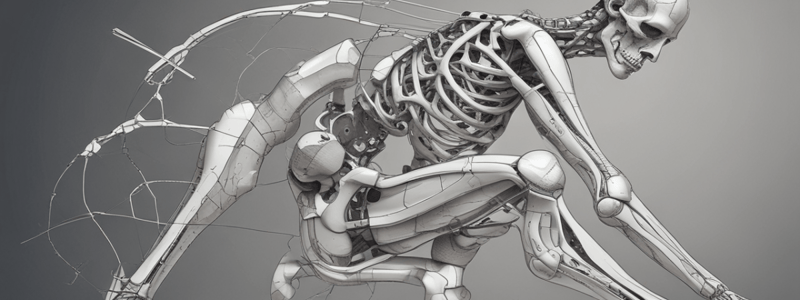Podcast
Questions and Answers
What is the primary reason for a fracture to occur?
What is the primary reason for a fracture to occur?
- When the bone is weak
- When the bone is old
- When the bone has a pre-existing condition
- When the force applied to a bone exceeds the bone's strength (correct)
What is the term for a bone that is misaligned, forming an angle between fractured fragments?
What is the term for a bone that is misaligned, forming an angle between fractured fragments?
- Displacement
- Subluxation
- Non-displacement
- Angulation (correct)
Which of the following signs is NOT a characteristic of a fracture?
Which of the following signs is NOT a characteristic of a fracture?
- Fever (correct)
- Obvious deformity
- Tenderness
- Swelling
What is the primary goal of splinting in the management of fractures?
What is the primary goal of splinting in the management of fractures?
What type of splint is used for stabilizing lower leg or forearm fractures?
What type of splint is used for stabilizing lower leg or forearm fractures?
What is the priority in transportation of patients with fractures?
What is the priority in transportation of patients with fractures?
What is the term for a partial dislocation of a joint?
What is the term for a partial dislocation of a joint?
What principle is used in the acute management of fractures?
What principle is used in the acute management of fractures?
Flashcards are hidden until you start studying
Study Notes
Fractures
- A fracture occurs when the force applied to a bone exceeds the bone's strength
- Types of fractures:
- Open (compound) fracture: break in the overlying skin, exposing the fracture to the outside environment
- Closed fracture: skin remains intact, not exposed
- Angulation: bone is misaligned, forming an angle between fractured fragments
- Non-displaced fracture: simple crack in the bone
- Displaced fracture: two bone ends are separated in at least one plane
Signs and Symptoms of Fractures
- Obvious deformity
- Shortening
- Swelling
- Bruising
- Discoloration
- Tenderness
- Pain, especially guarding or crepitus (grating sensation)
- Locked joint (difficult and painful to move)
Other Types of Injuries
- Dislocation: bone is totally displaced from the joint
- Subluxation: partial dislocation of a joint
- Sprains: stretched or torn ligaments
- Strains: injury to a muscle and tendon
- Achilles tendon rupture: usually occurs in athletes over 30 years old, involving sudden pain and inability to perform plantar flexion
Acute Management
- RICE (Rest, Ice, Compression, and Elevation) principle
- Pain control
- Separation of a limb or body part from the remainder of the body (amputation)
- Hemorrhage: severe bleeding from amputation
Assessment and Management
- Primary survey: managing ABCs (Airway, Breathing, and Circulation), identifying life threats, and getting patient priority
- Secondary assessment: full body exam, identifying hidden injuries, and evaluating circulation, motor function, and abnormal sensations
- Six Ps of musculoskeletal assessment: Pain, Paralysis, Paresthesia, Pulselessness, Pallor, and Pressure
- Reassessment: repeating primary survey, maintaining ABCs, and stabilizing injuries
Splinting
- Goals: immobilize the bone ends and adjacent joints, decrease pain and swelling, and prevent further injury
- Types of splints:
- Rigid splints
- Traction splints (for mid-shaft femur fractures)
- Pneumatic splints (for stabilizing lower leg or forearm fractures)
- Formable splints (vacuum splints, pillow splints, Sam splints, sling and swath, and pelvic binder)
Transportation
- Priority: patients with pulseless limbs or possible compartment syndrome
- Mode of transportation: helicopter or immediate ground transportation if treatment is 1 hour or more away
Fractures
- A fracture occurs when the force applied to a bone exceeds its strength
- Types of fractures include open (compound), closed, angulation, non-displaced, and displaced fractures
Characteristics of Fractures
- Open (compound) fracture: break in the overlying skin, exposing the fracture to the outside environment
- Closed fracture: skin remains intact, not exposed
- Angulation: bone is misaligned, forming an angle between fractured fragments
- Non-displaced fracture: simple crack in the bone
- Displaced fracture: two bone ends are separated in at least one plane
Signs and Symptoms of Fractures
- Obvious deformity
- Shortening of the affected limb
- Swelling and bruising
- Discoloration
- Tenderness and pain, especially with guarding or crepitus (grating sensation)
- Locked joint, making it difficult and painful to move
Other Types of Injuries
- Dislocation: bone is totally displaced from the joint
- Subluxation: partial dislocation of a joint
- Sprains: stretched or torn ligaments
- Strains: injury to a muscle and tendon
- Achilles tendon rupture: usually occurs in athletes over 30 years old, involving sudden pain and inability to perform plantar flexion
Acute Management of Injuries
- RICE principle: Rest, Ice, Compression, and Elevation
- Pain control is essential
- Separation of a limb or body part from the remainder of the body (amputation) may occur
- Hemorrhage: severe bleeding from amputation
Assessment and Management of Injuries
- Primary survey: managing ABCs (Airway, Breathing, and Circulation), identifying life threats, and getting patient priority
- Secondary assessment: full body exam, identifying hidden injuries, and evaluating circulation, motor function, and abnormal sensations
- Six Ps of musculoskeletal assessment: Pain, Paralysis, Paresthesia, Pulselessness, Pallor, and Pressure
- Reassessment: repeating primary survey, maintaining ABCs, and stabilizing injuries
Splinting in Injuries
- Goals: immobilize the bone ends and adjacent joints, decrease pain and swelling, and prevent further injury
- Types of splints include:
- Rigid splints
- Traction splints (for mid-shaft femur fractures)
- Pneumatic splints (for stabilizing lower leg or forearm fractures)
- Formable splints (vacuum splints, pillow splints, Sam splints, sling and swath, and pelvic binder)
Transportation of Injured Patients
- Priority: patients with pulseless limbs or possible compartment syndrome
- Mode of transportation: helicopter or immediate ground transportation if treatment is 1 hour or more away
Studying That Suits You
Use AI to generate personalized quizzes and flashcards to suit your learning preferences.



